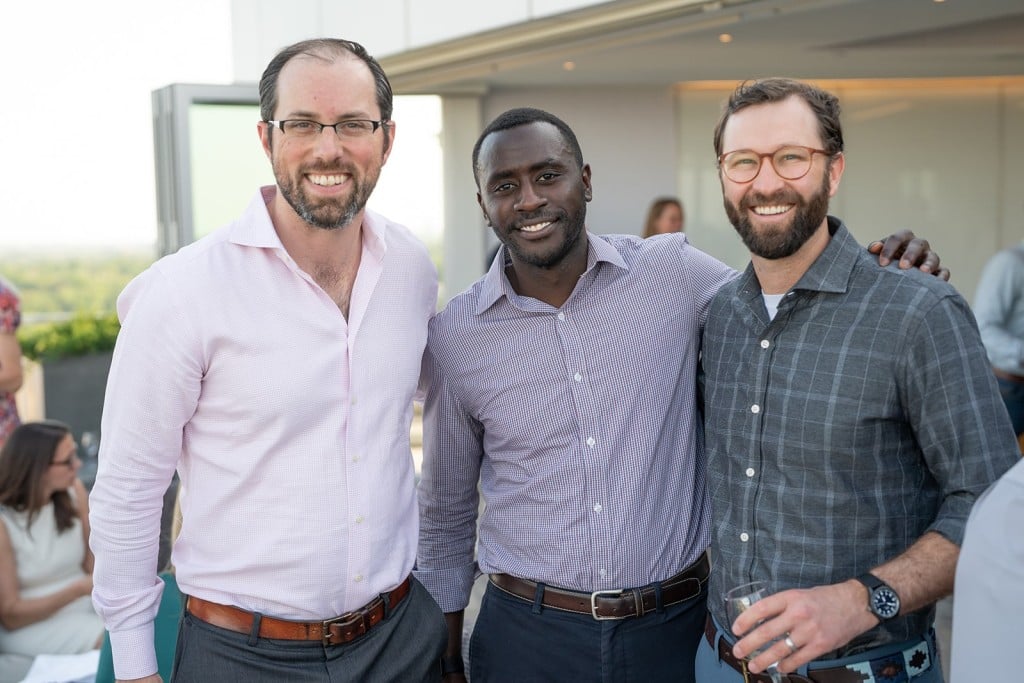Related Articles
Sands Capital portfolio managers reflect on five powerful lessons they have learned while investing through past downturns.
It’s been a very difficult year—one that has tested our approach like few others in our 30-plus year history. The experience has caused us to challenge our assumptions and acknowledge our mistakes. But it has also reminded us not to lose sight of what matters most to us over the long term, which is seeking to find high-quality businesses that offer the capacity to generate sustainable, above-average earnings over five years or more.
While the current downturn will undoubtably provide fresh insights, we have asked some of our portfolio managers to point to lessons learned from past downturns that have helped guide them through the current market environment. As Sands Capital President T. Perry Williams points out, downturns are all different, but many of them “rhyme.” As an institution of continuous learning, we hope to learn from these rhymes—to find the patterns that will help us better anticipate and adapt to future crises. It’s comforting to know many of our investment professionals have weathered past storms and are able to offer guidance and share their experience with the firm and our clients. It is also important to remember that these crises, too, like past crises, shall pass.
Lesson 1: Downturns Define Careers
T. Perry Williams, CFA
President, Portfolio Manager, Global Growth
29 years investment experience
Market downturns are all different, but many of them “rhyme.” To me, what we experienced in 2021 and 2022 felt very much like 2000. In both periods, asset prices inflated to a point that they created a bubble. Both were speculative periods followed by intense corrections. In the more recent period, the correction was accelerated by the Federal Reserve aggressively raising interest rates.
I started my investment career in the 90s. Back then, portfolio managers used to highlight lessons learned from the early 70s. But just think of all the crazy things that have happened over the past 30 years. It has been a roller coaster, to say the least, with a lot of experience gained along the way. A few years ago, someone told me that 70 percent of portfolio managers had never managed money in a bear market. Today that number is zero.
While this is painful in the moment, I assert that in five or 10 years we will look back on this as another defining moment. It is important to reflect on what is happening and why. I’ve emphasized to younger staff to not let fear get in the way of courage and conviction. It is easy to lose confidence and not speak up during periods of intense stress. As hard as it is to live and work through times like these, typically the world and markets are more rational after these types of systematic resets.
It is a cliché that bull markets die on euphoria. There is a lot of truth in this statement. In retrospect, 2021 was clearly a “euphoric” time despite being the height of a pandemic. There was intense euphoria around meme stocks, cryptocurrencies, non-fungible tokens (NFTs), and special purpose acquisition companies (SPACs). These things dominated the news cycle, creating FOMO—fear of missing out—and inflating asset prices. It was a bit crazy, to say the least.
And just as bull markets end in euphoria, bear markets typically end in despair. When I hear the word “despair,” I’m reminded of the movie “The Princess Bride” when Westley wakes up strapped to a table and asks, “Where am I?” His captor replies, “The Pit of Despair … and don’t even think about trying to escape … the chains are far too thick!” Are we in the Pit of Despair? Some days it sure feels like it.
Still, it’s important to remember that this, too, shall pass. Market bottoms aren’t a point in time. They are a process. On the one hand, this is a depressing experience; it’s easy to feel hopeless. However, there is a good reason to be optimistic. Historically, when pessimism is at its highest, markets tend to reverse course and rebound, anticipating brighter days ahead.
As growth investors in innovative businesses, drawdowns tend to affect us before the broader market. Despite the volatility we experienced in 2022, many of the businesses we own have continued to grow at above-market rates, gaining market share. Therefore, I anticipate that we will experience the inevitable upturn before the rest of the market. Our founder, Frank Sands Sr., was fond of saying: “You have to be there. You can’t be getting there.” That statement is true now more than ever, in our view.
To be clear, we made mistakes leading up to the sell-off of 2021 to 2022. We could have lowered our exposure to some of our high-growth companies with elevated short-term valuations, moving money into businesses with more classic growth profiles. While this might have blunted the pain, I don’t believe that we could have averted this drawdown without fundamentally changing our philosophy and process.
As a long-term investor, our goal—as hard as it may be in the moment—is to own attractive businesses that meet our six criteria and to focus on the long term. Still, we were unprepared for the massive value compression that followed the crush of rising rates and inflation and business fundamentals that did not support the valuations of growth businesses in a post-COVID-19 environment.
When all the dust settles, we will look back with hindsight, evaluate outcomes, and ask ourselves what we could have done better. We are actively looking at how to better understand and integrate the risk analytics tools at our disposal and to better integrate them into the portfolio management process.
Lesson 2: Tech Stocks are the First Casualty of a Panic
Thomas H. Trentman, CFA
Sr. Portfolio Manager, Select Growth and Technology Innovators
19 years investment experience
The typical path of a market downturn for technology companies is “shoot first, ask questions later,” followed by a “sorting” phase and, ultimately, recovery. That is because the vast majority of the value of tech companies—especially the higher growth ones—comes from future earnings. So uncertainty about their growth can increase dramatically during a downturn. This process is usually extremely painful for long-term investors who focus on compounding growth franchises and who don’t trade on macroeconomic gyrations. While that can be trying, after the initial panic, the “sorting” phase starts as the market starts to learn which businesses are structurally overvalued, which have durable competitive advantages, and which are still early in their growth opportunity. Our job as fundamental investors is to make sure we select businesses that have secular growth drivers, durable competitive advantages, and rational valuations. While businesses with these attributes will not be immune to a downturn, we believe they should fare better through the cycle.
Valuations are most noticeably affected in the recovery period of the sorting phase. Valuations were extended headed into 2000 and 2022. As a result, recovery took a long time for many businesses. That compares with 2008, when valuations were quite reasonable, and recovery was faster.
Our leadership and competitive advantage investment criteria lead us to the companies that, while not immune to downturns, can become stronger during them. Following a downturn, weaker competitors can often either get into trouble or cut costs to preserve margins at the expense of growth. Downturns often weed out subscale competitors that had been spending heavily and, as a result, are forced to retrench.
We are attracted to companies that we believe can achieve sustainable above-average growth. This position of strength gives them the ability to survive periods of uncertainty that may pressure their share price. The secular nature of their growth gives them some ability to “create their own weather,” which manifests in two ways. First, growth rates for these businesses often decelerate less than for more mature or cyclical companies, and second, they often get a boost from secular growth drivers as the downturn ends.
Markets typically overshoot as they weed out the weaker players. We have no delusions that we will be correct all the time. However, we believe that the depth of our research, the strength of our culture, and our dedication to our investment philosophy lead us to attractive businesses that will prevail in the sorting phase.
Lesson 3: Maintain Quality as Centerpiece of Investment Approach
Sunil H. Thakor, CFA
Senior Portfolio Manager, Global Leaders and International Growth
25 years investment experience
Bear markets and weak economic environments can be hard on every business, regardless of quality. Growth slows, and the valuation the market is willing to put on an asset compress. This is unavoidable. What matters, though, is not the short-run valuation but rather the long-run earnings power of the franchise. An empirical reality of long-term equity investing is that compounding of earnings growth swamps shifts, even large ones, in valuation. In our view, this makes bear markets like the current one such important times to reflect on “first principles” and the importance of owning “quality.”
At Sands Capital, we define quality in the context of our six investment criteria, most importantly, seeking to own businesses that are leaders in what they do, have strong underlying economics, are financially sound, and have built strong competitive moats around their franchises. We believe that these are the qualities that enable a business to sustain above-average earnings growth over long periods. Critically, these characteristics also have as much to do with mitigating business risk—or the risk of a permanent loss of capital—during a challenging environment as they do with driving growth and value creation during a strong environment.
Having quality as the centerpiece of our investment approach allows us to confidently stay the course during a weak market and economic environment, as we view excess valuation compression as a divergence between price and value rather than an erosion of intrinsic value. Similarly, we view near-term earnings headwinds as largely temporary.
We are often asked how we “pivot” portfolio positioning in a market like the current one. Our answer is: Pivot to what? Lower-quality businesses? Businesses with less growth and value creation potential? Cheaper stocks that may come with shallower moats?
For the most part, our view of the long-term earnings power of the franchises in which we invest is largely unchanged over the last year, even in cases in which our near-term earnings estimates have come down. That’s because most of the businesses in which we invest are beneficiaries of longer-term secular trends that remain in place despite cyclical weakness. By seeking to own leaders with strong economics, we believe that the businesses in which we invest are better positioned than peers to continue investing for long-run growth despite weaker near-term prospects, so they will, in many cases, increase the size of their relative competitive advantage versus peers coming out of the current downturn. Successful investing often requires comfort with discomfort—in this case, the discomfort of the near-term market and economic environment overshadowing the underlying long-term prospects of many of our investments.
On this score, we are reminded of Benjamin Graham’s famous adage: “In the short run, the market is a voting machine, but in the long run, it is a weighing machine.” Having practiced our long-term, business-focused growth approach over many market cycles, our experience is that far more value can be added over the long run by seeking to own leading, high-quality business franchises that we believe will deliver long-term growth, even when the short-term “vote” of the market signals the opposite. Underlying asset quality, as defined by our six investment criteria, gives us the confidence to be comfortable being uncomfortable.
Lesson 4: Clear Missions and Solid Financials are Critical to Survival
Danielle J. Menichella, CFA
Portfolio Manager, Global Shariah and International Growth
27 years investment experience
At Sands Capital, we seek to own innovative, quality businesses that operate in spaces with attractive underlying economics and have market-leading positions and sustainable competitive moats that allow them to potentially benefit from secular shifts and grow over the long term. Because we aim to own a business for five years—and hope to own it for much longer—when we do research on a business, both before writing a recommendation and throughout the ownership period, we strive to continuously look out over the next 10-plus years. In addition to the analyst’s focus on every detail of each business, we develop a broader “What Matters” framework for portfolio context. This framework breaks down each investment case into a few key insights into what we believe needs to play out over time for the investment case to work. It allows us to focus on the long-term strengths and potential of the business without getting sidetracked by short-term noise, all while staying keenly focused on risks that could prove to be not just near-term but also long-term game changers.
A big reason why we have conviction in this “what matters” framework comes from our conviction in the management team making the decisions and implementing the strategic vision. We believe that is best done when a clear value-added mission statement is regularly articulated, and the team is laser-focused on bringing value-added solutions to its customers, regardless of sector. This is the fourth of our six investment criteria.
It is through the execution of criterion No. 4 that we seek to garner shareholder trust, a belief that the company is being managed with respect to minority shareholders and generating attractive returns over time, as well as a strong commitment to environmental, social, and corporate governance issues. This criterion is always important to us, but this is especially true during times of distress. Our experience has shown that when management teams lack this strongly articulated mission, they can be more easily sidetracked during difficult times. Just like our clients hire us to be a growth investor and do not want us to change what we do in the short term; we want to make sure our management teams do what they promise over the long term.
This commitment goes hand in hand with our fifth criterion, financial strength. We seek highly transparent business models and revenue streams that have a path to strong free-cash-flow generation, margins and returns. We always look for businesses that have sufficient cash to support growth and that lack significant debt, but this is especially important during market downturns, as short- term economics could affect growth and profitability. At the same time, financial strength could provide an opportunity for strong market leaders to continue to invest in solutions and customers, win more market share, and grow when weaker competitors or those that lack strong balance sheets will have to rein in spending, potentially losing market share or even having to exit the space. We find that many of our businesses can emerge from distressing times even stronger than they were before, with more market share in an easier competitive landscape, often because of their value-added mission and strong financials.
Additionally, financial strength provides comfort even in markets like we’ve recently seen, when stock prices are falling, and investors are uncertain. We don’t want to have businesses that need to raise significant debt in such environments to continue to grow. We also don’t want to have to rely on an equity raise to fund growth during such times. Our businesses, for the most part, are able to grow organically and inorganically via their own cash flow and balance sheets. Their management teams are generally able to stay focused on their missions as well, further reducing the potential need for additional sources of funding. This is what our six criteria were designed to identify.
Lesson 5: Emerging Market Leaders Rise in Downturns
Brian A. Christiansen, CFA
Sr. Portfolio Manager, Global Growth and Emerging Markets Growth
18 years investment experience
While financial strength can serve as a risk mitigator for all companies in all geographies in a downturn, my experience tells me it is particularly important in emerging market economies.
Because many emerging market economies are often more informal, less consolidated, and more capital constrained, financially strong companies in emerging markets have often been able to go on the offensive and use adversities created by bear markets to their advantage. We have seen companies expand their market share, make selective acquisitions to consolidate a market, innovate to find new ways to add value for their customers, and benefit from more favorable terms with suppliers and/or lease agreements when they are able to continue to invest in growth while competitors are not. Financial strength is also critical for companies to not just survive but to thrive coming out of downturns because access to capital can completely dry up for small- and medium-sized enterprises, which in less formal economies often represents the biggest source of competition.
We learned this lesson the hard way with Netshoes, which was a leading athletic apparel ecommerce retailer in Brazil when we purchased the business in 2017. Over the course of our ownership, Netshoes failed to convert its leadership position in athleisure to fashion, which was a key pillar of our investment case.
In order to displace the then-category leader, not only did Netshoes have to offer a differentiated product, but it also needed a significant amount of capital. Unfortunately, it wasn’t in a position to do so: it had already become highly levered by taking on working capital loans to fund growth and it wasn’t in a position to raise equity capital given its depressed stock price. While raising capital from a strategic investor was a potentially attractive option, it wasn’t necessarily one that was in the company’s control.
Ultimately, the business’ lack of financial strength didn’t allow it to make the necessary investments to cement its leadership position. We exited the business in 2018.
A memorable example of a severe macroeconomic slowdown in an emerging market economy was Brazil from 2014 to 2016, when the country experienced its worst recession since the Great Depression, contracting approximately 8 percent.
Drugstore retailer Raia Drogasil was one of the only free-cash-flow-positive retail pharmacy chains with a robust balance sheet and strong store unit economics going into the downturn. During that period, the drugstore chain used its financial strength to seize a structural opportunity in the retail pharmacy market—the shift from less formal mom-and-pop stores to more formal and sophisticated retail chains with better store locations, wider product selection, fewer stock-outs, and superior back- end and consumer-facing technology. Thanks to its solid financial footing, Raia was able to accelerate new store openings while many of its competitors were forced to slow the pace of new store openings, close a large number of existing stores, and limit investments in working capital to conserve cash and service rising debt payments in a rising interest rate environment. That helped Raia Drogasil to secure better store locations at more favorable terms and gain market share from the smaller shops as the pharmacy retail market continued to formalize.
Latin American ecommerce giant MercadoLibre is another example of financial strength in action. It was one of the only ecommerce companies with positive free cash flow and a robust balance sheet during the region’s downturn, so it was able to accelerate investments into adjacent businesses, such as payments and logistics, which helped it improve the overall customer experience and increase revenue generation with an expanding take rate. Additionally, MercadoLibre’s value proposition relative to physical retail became more widely appreciated as consumers became even more sensitive to price, and more sellers looked to expand distribution channels beyond physical stores. As a result, MercadoLibre benefited from an accelerated shift from offline to online shopping and grew its market share online.
Management teams are often instrumental in a downturn, because entrepreneurial teams can take advantage of a crisis to find opportunities to modernize and add value for their customers, for instance. Brazilian car rental company Localiza is a great example of this. We did not own the company during the recession. However, our decision to purchase it in June 2019 and own it today partly reflects our appreciation for resilience and creativity of the management team during that challenging time.
During Brazil’s economic crisis, which began in 2014 and lasted into 2017, interest rates rose to 14.25 percent, the highest level in recent history. These high financing costs impaired weaker competitors, causing car sales in the country to plummet by 44 percent in that period. When competitors were struggling to keep afloat, and fewer individuals and companies were purchasing cars, Localiza took the opportunity to buy its raw material from original equipment manufacturers at more favorable terms, widening its competitive edge.
As consumers became more price sensitive, the appeal of renting rather than buying a car rose significantly. Due to the strength of its balance sheet and superior access to low-cost credit, Localiza was able to take advantage of this opportunity by cutting rental prices and expanding its vehicle fleet. Meanwhile, many of its peers were forced to decrease their fleets to meet their cash flow needs. In addition, ride-hailing was beginning to take off during Brazil’s recession, but it was a very difficult time for drivers who lacked access to capital and thus had a hard time meeting the upfront costs necessary to buy a new vehicle. Localiza’s management recognized its opportunity to act as a strategic partner to ride-hailing drivers, so it launched a new monthly rental service tailored to ride-hailing drivers at a discounted rate. The company used the crisis to create a win-win opportunity for its own business and the ride-sharing industry. Today, ride-hailing drivers account for one-third of Localiza’s total rentals to individuals. The company also announced its acquisition of Hertz Brazil, and it is entering a strategic partnership with Hertz with respect to inbound/outbound travel in Brazil, benefiting both organizations.
My final lesson is that, from a capital allocation perspective, one needs to be careful separating microeconomic from macroeconomic elements in a downturn, as the two are often intertwined. So looking again at Brazil, we saw how recessions affected different industries and companies differently. Some companies are much more macro-dependent, and others are much more able to “create their own weather.” So rather than equally trimming or selling all holdings in Brazil, for example, it is critical to determine which companies can create their own weather and are thus more likely to come out of a downturn in an advantaged rather than disadvantaged position. We want to assess each company based on its financial strength and its qualitative ability to strengthen its competitive advantage. Reacting to that is far more important than just reacting to a stock price pullback or a depressed valuation.
Disclosures:
This content was posted on September 6, 2024.
The views expressed are the opinion of Sands Capital and are not intended as a forecast, a guarantee of future results, investment recommendations or an offer to buy or sell any securities. The views expressed were current as of the date indicated and are subject to change. This material may contain forward-looking statements, which are subject to uncertainty and contingencies outside of Sands Capital’s control. All investments are subject to market risk, including the possible loss of principal. Readers should not place undue reliance upon these forward-looking statements. There is no guarantee that Sands Capital will meet its stated goals. Past performance is not indicative of future results. A company’s fundamentals or earnings growth is no guarantee that its share price will increase. Forward earnings projections are not predictors of stock price or investment performance, and do not represent past performance. There is no guarantee that the forward earnings projections will accurately predict the actual earnings experience of any of the companies involved, and no guarantee that owning securities of companies with relatively high price to earnings ratios will cause a portfolio to outperform its benchmark or index. Company logos and website images are used for illustrative purposes only and were obtained directly from the company websites. Company logos and website images are trademarks or registered trademarks of their respective owners and use of a logo does not imply any connection between Sands Capital and the company. GIPS Reports found here.
The businesses mentioned by the Sands Capital team illustrate examples of current and former emerging market holdings that were challenged by previous market downturns. As of August 26, 2024, Raia Drogasil, MercadoLibre, and Localiza were holdings in Sands Capital strategies and our largest holdings either domiciled in or with meaningful operations in Brazil.
The specific securities identified and described do not represent all the securities purchased, sold, or recommended for advisory clients. There is no assurance that any securities discussed will remain in the portfolio or that securities sold have not been repurchased. You should not assume that any investment is or will be profitable. A full list of public portfolio holdings, including their purchase dates, is available here.
The growth style of investing may become out of favor, which may result in periods of underperformance. The strategies are concentrated in a limited number of holdings. As a result, poor performance by a single large holding of a strategy would adversely affect its performance more than if the strategy were invested in a larger number of companies. International investments can be riskier than US investments due to the adverse effects of currency exchange rates, differences in market structure and liquidity, as well as specific country, regional and economic developments. Investments in emerging markets are subject to abrupt and severe price declines. The economic and political structures of developing nations, in most cases, do not compare favorably with the US or other developed countries in terms of wealth and stability, and their financial markets often lack liquidity. Because of this concentration in rapidly developing economies in a limited geographic area, emerging markets strategies involve a high degree of risk. The strategies may experience losses as they are subject to equity securities risk, market and issuer risk, selection risk, growth style risk, concentration risk, currency exchange risk, foreign company risk, derivatives risk and other economic risks that may influence returns.
This communication is for informational purposes only and does not constitute an offer, invitation, or recommendation to buy, sell, subscribe for, or issue any securities. The material is based on information that we consider correct, and any estimates, opinions, conclusions, or recommendations contained in this communication are reasonably held or made at the time of compilation. However, no warranty is made as to the accuracy or reliability of any estimates, opinions, conclusions, or recommendations. It should not be construed as investment, legal, or tax advice and may not be reproduced or distributed to any person.


















